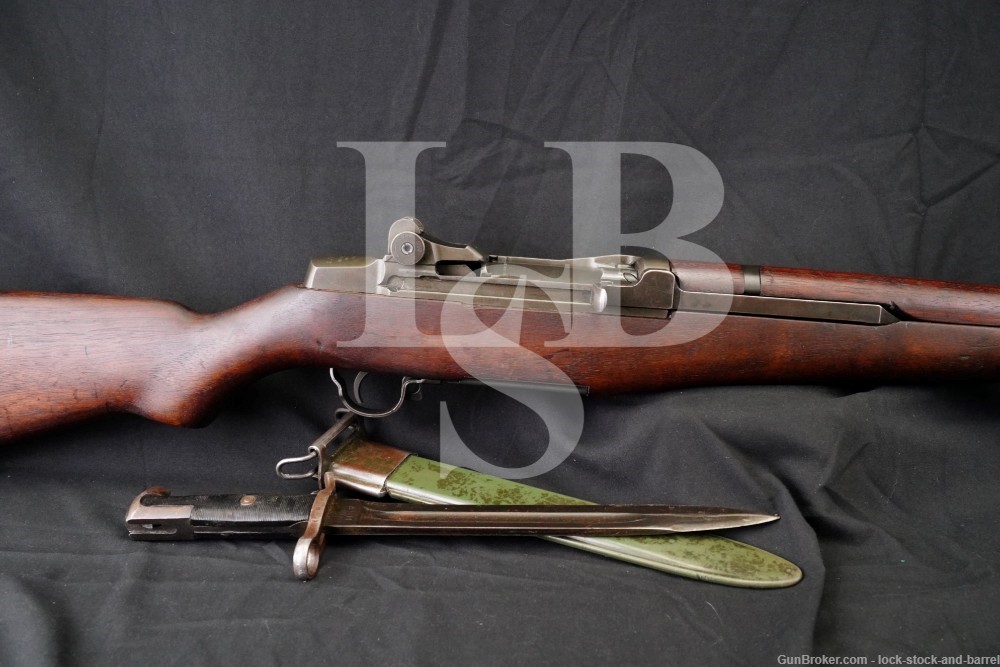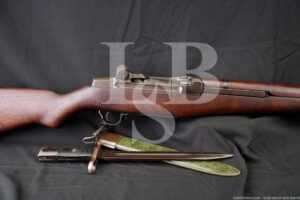
H&R M1 Garand US Harrington & Richardson U.S. Semi Auto Rifle C&R
SOLD FOR: $2675
LSB#: 230115BY008
Make: Harrington & Richardson (H&R) Arms Company
Model: M1 Garand. The rifle’s action uses H&R parts. The LMR barrel is original. LMR supplied barrels to the H&R factory.
Serial Number: 5648423
Year of Manufacture: 1954. Barrel Date: August 1953
Caliber: .30-06 Springfield
Action Type: Semi-Auto, En Bloc Clip Fed
Markings: There is no import mark. The gas cylinder lock screw is marked “HRA” which is a Harrington & Richardson part (page 115 of Joe Poyer’s M1 GARAND 1936 to 1957, 6th Edition).
Receiver: “U.S. RIFLE / CAL. .30 M1 / H. & R. ARMS CO. / 5648423”
Trigger Group: “6528290—HRA N”- An H&R part (page 90).
Hammer: “5546008-HRA N”– An H&R part (page 97).
Safety: “HRA” – An H&R part (page 104).
Follower: unmarked – An H&R part (page 83).
Receiver Leg: “6528291” – Correct for a 1954 H&R M1 (page 30).
Op Rod: “6535382 HRA.” – An H&R part (page 71).
Bolt: “D6528287 HRA / .U.”- An H&R part (pages 51 & 52).
Barrel:“LMR” (Line Material Company of Birmingham, Alabama), “D6535448”, “8 53 A19”, “P”, “M” and with a “crossed cannons” stamp – LMR provided barrels for International Harvester (pages 63 – 65 Poyer).
The stock and sights are described below.
Barrel Length: Approximately 24 Inches
Sights / Optics: The front sight is a blade set between two protective wings. The rear sight is a fully adjustable aperture sight set between two protective wings. The windage knob is marked “LEFT arrow” twice and “HRA-W”. The elevation knob is marked from “2-12” in increments of two and “HR A”. These are H&R rear sight markings (page 39-40).
Stock Configuration & Condition: The face of the grip is marked with “circled P” proof. The left side of the stock above the trigger is with a Defense “Eagle” acceptance stamp which is correct for an M1 stock made after Sept./Oct. 1953 (page 129-130).
The oil stained hardwood stock has a pistol grip, metal nosecaps, stacking loop, two sling loops, and a metal buttplate with hinged metal door for storage in the buttstock. The buttplate shows scrapes, scratches and some light surface erosion. The stock shows numerous scrapes, scratches & compression marks. Some have damaged small portions of the surface wood. The wood has been oiled. The LOP measures 13 inches from the front of the trigger to the back of the buttplate. The stock rates in about Very Good overall condition.
Type of Finish: Parkerized
Finish Originality: Original
Bore Condition: The lands are bright. The muzzle and grooves are semi bright. The rifling is deep. There is fouling in the grooves which should clean up some. There is erosion near the muzzle and light intermittent erosion in the remaining grooves. The bore shows an M.E. of 0.8. The throat shows a T.E. of 1.5.
In this writer’s opinion, this bore rates a 7 out of 10.
Many military and C&R-eligible weapons have bores that will show erosion. This is not only due to age but to the fact that corrosive primers were commonly used in ammunition worldwide. For example, the U.S. used corrosive ammunition throughout WWII. The U.S. military did not begin to phase out corrosive-primed ammunition until the 1950s.
Overall Condition: This rifle retains about 92% of its metal finish. The metal shows scrapes, small scratches and thinning on the leading edges. The bottom rear of the receiver shows light thinning and discoloration from oxidation. The receiver and op rod show areas of discoloration from both oil residue and oxidation. The action shows operational wear. The markings are deep. Overall, this rifle rates in about Very Good Plus condition.
Mechanics: The action functions correctly. We did not fire this rifle. As with all used firearms, a thorough cleaning may be necessary to meet your maintenance requirements.
Box, Paperwork & Accessories: The rifle comes with an M1 bayonet and scabbard. The bayonet blade is marked “AFK / flaming bomb / US” and the crosspiece is marked “E 10940”. The bayonet mounts the rifle properly. There are cleaning tools stored in the butt. They include a plastic oiler, combination tool and a 4 piece cleaning rod & loop.
Our Assessment: The M1 Garand had garnered a well-deserved reputation as the best standardized service rifle of WWII. At the end of WWII large numbers of Garands were in inventory and it was assumed they were sufficient to meet future military needs. That all changed when the Korean War broke out. Springfield Armory ramped up its Garand production line as quickly as possible, but additional sources were needed. International Harvester was contracted to produce M1 Garands in 1951. On April 3, 1952, H&R was given a contract for the production of M1 Garand rifles.
H&R had produced a number of types of firearms for the civilian market, but H&R’s prior experience in military firearm production for the government was primarily limited to the Reising .45 ACP submachine gun that it made during World War II. H&R was able to capitalize on its arms making experience during production and supplied International Harvester with assistance in producing M1 Garands. Unlike the mix of parts found on some IHC M1 Garands, there was typically much more consistency in the H&R rifles including the format of the receiver markings. Unlike IHC, H&R made its own barrels for most of the company’s production run. When International Harvester opted out of its contact, a number of the Line Material Corp. (LMR) barrels on hand were diverted to H&R and used to assemble some late-production rifles. LMR barrels are considered high quality barrels.
This Harrington & Richardson M1 Garand was made back in 1954. The rifle’s action uses all H&R parts. The LMR barrel is original. LMR provided barreslto H&R for assembly at the factory. Even the gas cylinder lock screw and rear sights are marked “HRA”. This is quite the collectible rifle. It comes with an M1 bayonet & scabbard.
…Now go shoot something!

